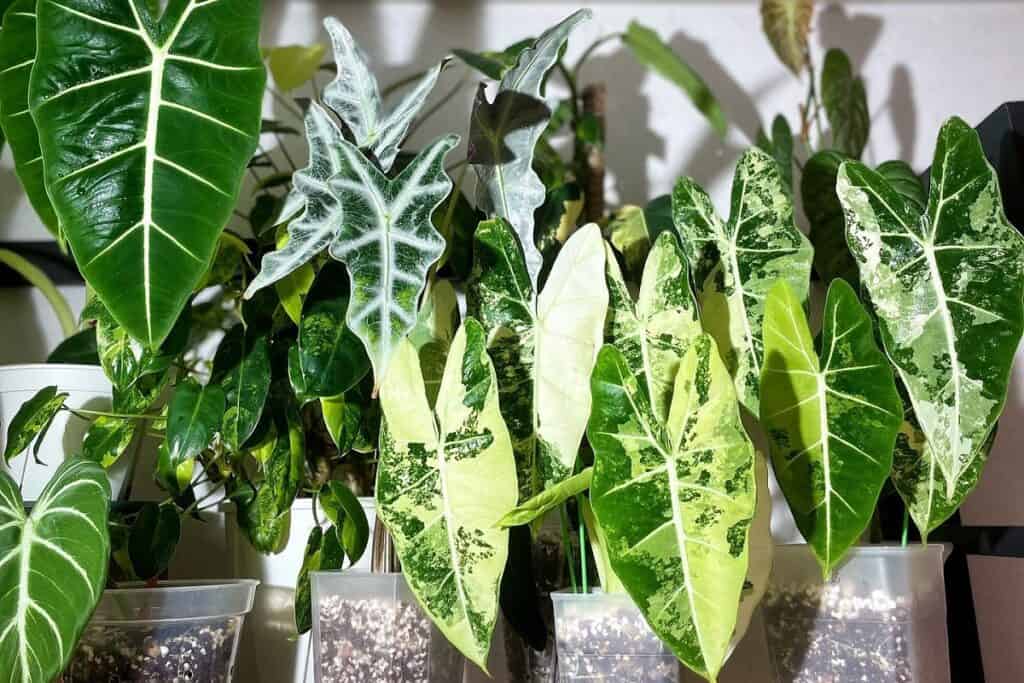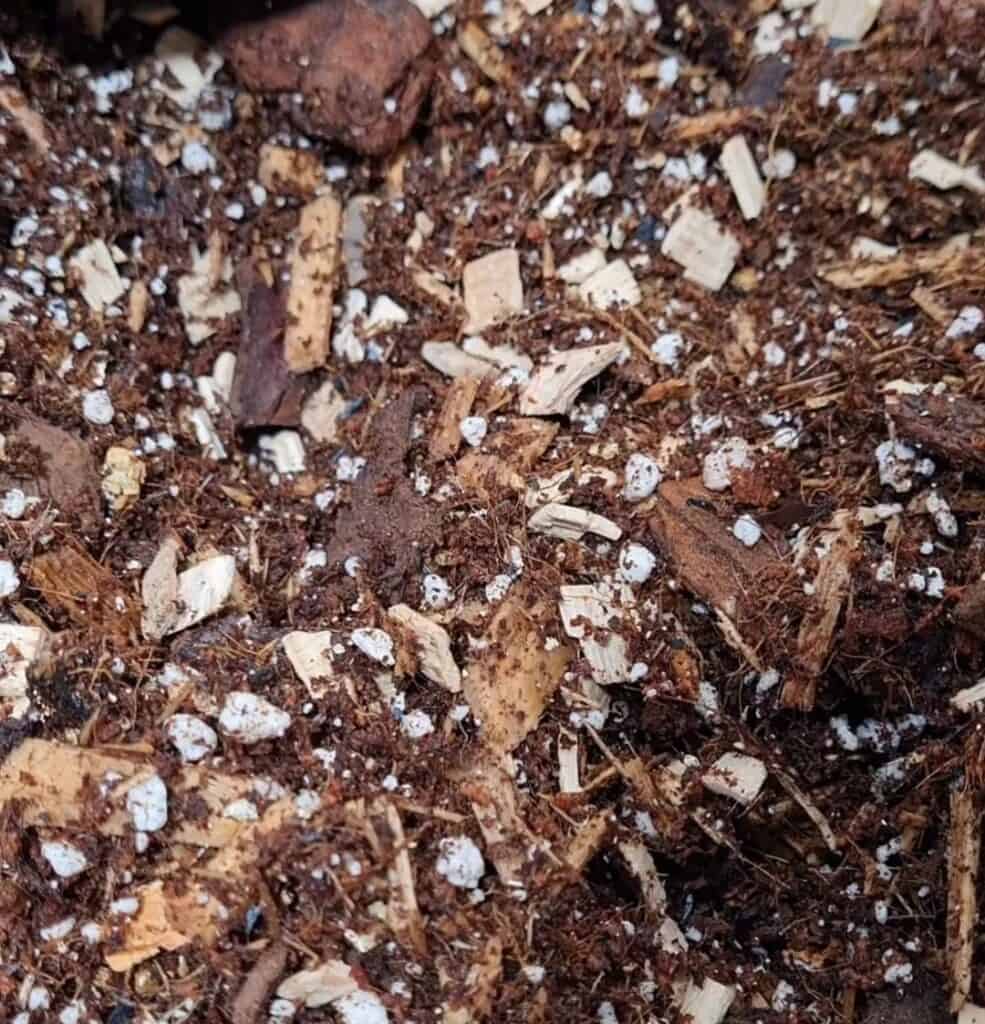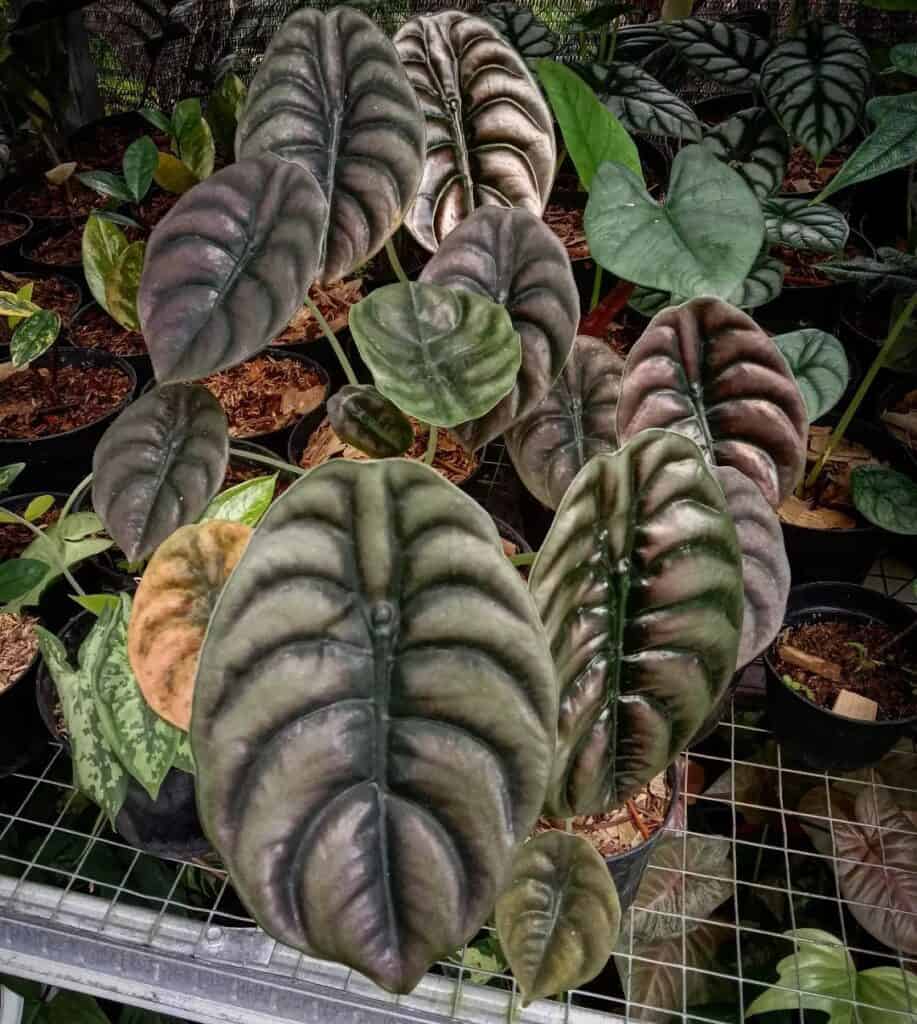If you are looking for a way to give your Alocasia plants the best environment possible, then look no further! This Alocasia soil mix recipe will provide the necessary elements for the Alocasia plants to flourish. With the right ingredients, you can create the perfect environment for your Alocasia plants to thrive. The ingredients in this soil mix recipe will help with drainage, aeration, and nutrient retention, which will help your Alocasia plants remain healthy and happy for years to come.

Contents
- 1 Ingredients For Alocasia Soil Mix Recipe
- 2 Directions For Mixing
- 3 Benefits Of An Alocasia Soil Mix
- 4 Different Variations Of The Recipe
- 5 Where To Buy Soil Ingredients
- 6 Troubleshooting Common Issues
- 7 Tips And Tricks For Growing Alocasia
- 8 Frequently Asked Questions
- 8.1 What Type Of Soil Should I Use For My Alocasia Plant?
- 8.2 Is Organic Soil Mix Better For Alocasia?
- 8.3 Can I Use Cactus Soil For Alocasia?
- 8.4 Do Alocasia Like Coco Peat?
- 8.5 Do Alocasias Like Peat Moss?
- 8.6 Do Alocasia Like Compact Soil?
- 8.7 Do Alocasia Like Orchid Soil?
- 8.8 Can Alocasia Grow Without Soil?
- 8.9 Is Sphagnum Moss Good For Alocasia?
- 8.10 How Do You Grow Alocasia In Perlite?
- 9 Conclusion
Ingredients For Alocasia Soil Mix Recipe
When it comes to creating the best soil mix for Alocasia plants, there are a few key ingredients you will need to create the perfect growing environment.
The primary ingredient for your Alocasia soil mix is well-draining potting soil. This type of soil will help to ensure that your Alocasia plant’s roots have access to the proper air and water levels it needs to thrive. You can make your own mix with common components such as peat moss, perlite, and vermiculite.
In addition to potting soil, you should also add a layer of organic material such as compost. Compost will add essential nutrients to the soil and help to create a well-balanced environment for your Alocasia plant.
You should also include some fertilizer in your soil mix to help your Alocasia plant get the nutrients it needs to grow. A slow-release fertilizer is a great option as it will provide your plant with a steady stream of nutrients over a longer period of time.
Directions For Mixing
Mixing the best Alocasia soil mix recipe is easy and requires only a few simple steps.
First, combine potting soil, coarse sand, and coconut chips in a bucket. The ratio of these ingredients should be 1:1:1. The sand should be coarse, and the potting soil should be fine. Make sure there are no lumps in the mixture.
Second, add some compost and slow-release fertilizer. This will provide the Alocasia with the nutrients it needs to grow and thrive. The compost and fertilizer should be added at a rate of 10-15% of the total soil mix.
Third, mix in some perlite. This will help the soil mix to drain properly and keep it from becoming too compact. Add in the perlite at a rate of 20-30% of the total soil mix.
Finally, stir the soil mix ingredients together until everything is evenly distributed. Once the Alocasia soil mix is complete, it is ready to be used. Be sure to store the soil mix in a cool, dry place until you are ready to use it.

Benefits Of An Alocasia Soil Mix
An Alocasia soil mix is a great way to provide your Alocasia plants with the proper environment and nutrition they need to thrive. There are many benefits to creating a custom soil mix for your Alocasia plants, such as improved drainage, increased nutrient availability, and enhanced root growth. Each of these benefits can help you create a healthy and successful growing environment for your plants.
1. Improve drainage
Alocasia plants prefer soil that is slightly moist, but not wet or soggy. Creating a soil mix with the right balance of perlite, potting soil, and coarse sand can help ensure that your plants are getting the drainage they need to thrive. Additionally, using a soil mix with perlite will help to aerate the soil, allowing for better root growth.
2. Increase nutrient availability
A soil mix that is tailored to the needs of your Alocasia plants can ensure that the nutrients are available for the plants to absorb. Compost, worm castings, and other organic fertilizers can help provide essential nutrients to your plants, such as nitrogen, phosphorus, and potassium. Additionally, adding nutrient-rich soil amendments can help create a better balance of nutrients for your plants.
3. Enhance root growth
A soil mix that is tailored to the needs of your Alocasia plants can help create an environment with ideal pH levels and increased aeration. This can help your plants establish deeper and stronger root systems, which can help to promote better growth and healthier plants.
Different Variations Of The Recipe
Once you have the basic soil mix for Alocasia, there are many different variations you can experiment with to get the perfect recipe for your plants. Here are some ideas for different variations of the recipe:
1. Add more organic matter: This could be compost, manure, or a combination of both. Adding organic matter will give your soil mix a boost of nutrients, which will help your Alocasias thrive.
2. Adjust the pH of the soil mix: Alocasias prefer slightly acidic soil, so adding some soil amendments like peat moss or cactus soil can help adjust the pH.
3. Add perlite or vermiculite: These materials are great for aerating the soil and providing drainage. They also help retain moisture, which is important for Alocasias that are sensitive to over-watering.
4. Add some slow-release fertilizer: This will give your Alocasias a steady supply of nutrients throughout the growing season, helping them stay healthy and happy.
5. Add some soil amendments: This is to increase the availability of certain nutrients. Adding things like iron sulfate or kelp meal can help provide your Alocasias with the nutrients they need to thrive.
By experimenting with different variations of the basic soil mix recipe, you can find the perfect mix for your Alocasias. With a little bit of trial and error, you can create a soil mix that will keep your plants healthy and happy for many years to come.
Where To Buy Soil Ingredients
If you are looking to make your own soil mix for an alocasia plant, the first step is to gather the right ingredients. The best soils for alocasia plants are those that are well-draining, lightweight and rich in organic matter. Depending on where you live, there are a variety of places to buy soil ingredients.
Local nurseries or garden centers are a great place to start. Most of these stores will have a variety of soils, potting mixes and fertilizers that can be used to create the perfect alocasia soil mix. Additionally, some stores may also carry specialty ingredients such as vermiculite, perlite and coarse sand.
If you can’t find what you need at a local nursery or garden center, you can also purchase soil ingredients online. Many online stores such as Amazon and eBay have a wide selection of soils, potting mixes and fertilizers. You can also find specialty ingredients such as vermiculite and perlite online.
Finally, you can also find soil ingredients at home improvement stores such as Home Depot or Lowe’s. These stores typically have a variety of soils, potting mixes and fertilizers. Additionally, you can usually find specialty ingredients such as vermiculite and perlite at these stores.
No matter where you buy your soil ingredients, make sure to read the labels carefully and purchase the right type and amount for your alocasia soil mix. With the right ingredients and a little effort, you can create the perfect soil mix for your alocasia plant.
Troubleshooting Common Issues
When it comes to caring for Alocasia, it is important to ensure that the soil mix is the right mix for the plant. However, there can be common issues that can arise when growing Alocasia in a soil mix. Here are some tips for troubleshooting these common issues.
1. Root rot
Root rot is caused by too much moisture in the soil mix and can be prevented by ensuring that the soil mix is well-draining. To prevent Alocasia root rot, it is important to use an appropriate soil mix that has drainage materials such as perlite or coarse sand.
2. Too much fertilizer
Alocasia does not need a lot of fertilizer and too much fertilizer can be detrimental to the plant. To prevent this, it is important to use a balanced fertilizer that is appropriate for the plant and only fertilize when necessary.
3. Too much light
Alocasia thrives in bright, indirect sunlight, but too much light can cause the leaves to yellow and burn. To prevent this, it is important to keep the Alocasia in a spot that is not exposed to direct sunlight and avoid any sudden changes in light exposure.
4. Pests
Alocasia can be prone to pests such as aphids, mealybugs, and spider mites. To prevent this, it is important to inspect the plant regularly for signs of pests and take immediate action if any are found. It is also important to ensure that the soil mix is not too wet, as this can attract pests.
Tips And Tricks For Growing Alocasia

Growing Alocasia can be an exciting and rewarding experience, but it is important to follow a few tips and tricks to ensure the best possible outcome. Here are a few tips and tricks for growing an Alocasia that will help you get the most out of your plant.
1. Provide bright, indirect sunlight: Alocasia plants prefer bright indirect sunlight, so make sure to place your plant near a window that provides plenty of light without direct exposure to the sun.
2. Water regularly: Alocasia plants need to be watered regularly to keep their soil moist. However, be careful not to overwater, as this can cause root rot.
3. Fertilize your plant: Alocasia plants need to be fertilized regularly to stay healthy and grow. Use a balanced fertilizer that contains both nitrogen and phosphorus every two weeks during the growing season.
4. Watch out for pests: Alocasia plants are prone to pests, such as mealybugs and aphids. If you notice any pests on your plant, treat them immediately with an appropriate insecticide.
By following these tips and tricks for growing Alocasia, you can ensure that your plant will thrive and look its best. With a little bit of care and attention, your Alocasia will be sure to bring you plenty of joy.
Frequently Asked Questions
When it comes to caring for Alocasia plants, there are many questions that come up. To help you get the most out of your Alocasia plant, here are some of the most frequently asked questions.
What Type Of Soil Should I Use For My Alocasia Plant?
When it comes to finding the best soil mix recipe for your Alocasia plant, the type of soil you use matters. To get the best results, you should choose soil that is well-draining, acidic, and rich in organic matter.
For the base of your soil mix, you should use lightweight, high-quality potting soil. This will provide your plant with essential nutrients and ensure that it has enough air pockets to promote proper drainage. Additionally, you can add a small amount of coarse sand or perlite to increase the soil’s drainage.
You should also add a few handfuls of organic matter, like compost, leaf mold, or peat moss, to your soil mix. This will help to increase the soil’s acidity and improve its ability to retain moisture. Additionally, organic matter will provide your Alocasia plant with the extra nutrients it needs to thrive.
Finally, you should mix in a few handfuls of slow-release fertilizer to your soil mix. This will ensure that your Alocasia plant has the essential nutrients it needs to stay healthy and grow strong.
Is Organic Soil Mix Better For Alocasia?
Organic soil mixes are becoming increasingly popular when it comes to growing Alocasia plants, as they are known to be healthier and naturally more nutrient-rich than regular soil mixtures. Organic soil mixes contain compost and other natural ingredients, such as manure, leaves, and bark, as opposed to chemical fertilizers and synthetic additives. The organic soil mix also helps to keep the soil pH more balanced, which can be beneficial to Alocasia plants.
Organic soil mixes provide more nutrients than regular soil mixtures, which can help the Alocasia plants to grow faster and healthier. Compost and other organic matter help to feed the plant and improve drainage, which can be beneficial for Alocasia plants that require moist soil. Additionally, the organic matter helps to create a more hospitable environment for beneficial microorganisms, which can help to keep the Alocasia plants healthy.
However, organic soil mixes can be more expensive than regular soil mixtures and may require more maintenance. Organic soil mixes can become compacted over time, making it difficult for the Alocasia plants to absorb water and nutrients. Additionally, organic soil mixes can require more frequent repotting, as the nutrients are more likely to be depleted over time.
Ultimately, whether an organic soil mix is better for Alocasia plants is an individual decision. Organic soil mixes may be more expensive and require more maintenance, but they can provide more nutrients and help to create a more hospitable environment for the plants. Regular soil mixtures may require less maintenance, but they may not be as nutrient-rich or beneficial for the Alocasia plants.
Can I Use Cactus Soil For Alocasia?
Yes, you can use cactus soil for Alocasia. However, it is important to mix it with regular potting soil to ensure that the soil has enough nutrients for the plant. Additionally, you may want to add some organic matter, such as compost, to the soil to provide additional nutrients and help retain moisture.
Do Alocasia Like Coco Peat?
Yes, Alocasia plants do like coco peat. Coco peat is a great soil amendment, as it helps to retain moisture, while also providing a good drainage system. It also helps to add organic matter to the soil, making it more nutrient-rich.
Do Alocasias Like Peat Moss?
Yes, Alocasias do like peat moss in their soil mix. Peat moss helps to retain moisture in the soil and also helps to maintain a slightly acidic pH level, which is ideal for Alocasias.
Do Alocasia Like Compact Soil?
No, Alocasia plants prefer loose, well-draining soil with a slightly acidic pH. Compacted soil can lead to root rot, so it is best to avoid it.
Do Alocasia Like Orchid Soil?
No, Alocasia plants prefer a soil mix that is well-draining, rich in organic matter, and slightly acidic. Orchid soil is typically much too coarse and lacks essential nutrients for Alocasia plants.
Can Alocasia Grow Without Soil?
No, Alocasia plants cannot grow without soil. Most varieties of Alocasia need to be planted in a well-draining potting soil mixture that contains a blend of perlite, peat, and vermiculite. Additionally, Alocasia plants require regular watering and misting to ensure they are getting adequate moisture.
Is Sphagnum Moss Good For Alocasia?
No, sphagnum moss is not recommended for use with alocasia plants. This is because alocasia do not like to have their roots constantly wet, and sphagnum moss holds moisture for too long. Instead, use a light, peat-based soil mix to ensure adequate drainage.
How Do You Grow Alocasia In Perlite?
To grow Alocasia in perlite, start by filling a pot with a mixture of two parts perlite and one part potting soil. Plant the Alocasia rhizome about 4-6 inches deep and cover it with soil. Water the soil and keep it moist. Place the pot in an area with bright, indirect light and temperatures between 65-80°F.
Conclusion
Overall, this Alocasia soil mix recipe is an excellent choice for your Alocasia needs. It is economical to make, easy to mix, and provides your plants with the nutrients they need to thrive. With its combination of ingredients, you can rest assured that your Alocasia will be growing in a healthy and well-balanced environment. So why not give this soil mix a try? It just might be the best decision you ever make for your Alocasia!
